Chapter 15 Recombinant DNA Technology and Forensic Applications - Abby Made
1/88
There's no tags or description
Looks like no tags are added yet.
Name | Mastery | Learn | Test | Matching | Spaced |
|---|
No study sessions yet.
89 Terms
What is recombinant DNA technology?
A technique for making recombinant DNA molecules using cloning and expression vectors.
What is the purpose of cloning vectors in recombinant DNA technology?
Cloning vectors are used to make copies of an isolated gene or any fragment of DNA of interest.
What are the components of the pUC18 cloning vector?
The pUC18 cloning vector includes the ampR gene (ampicillin resistance), the lacZ+ gene (codes for b-galactosidase), and a polylinker region with restriction sites.
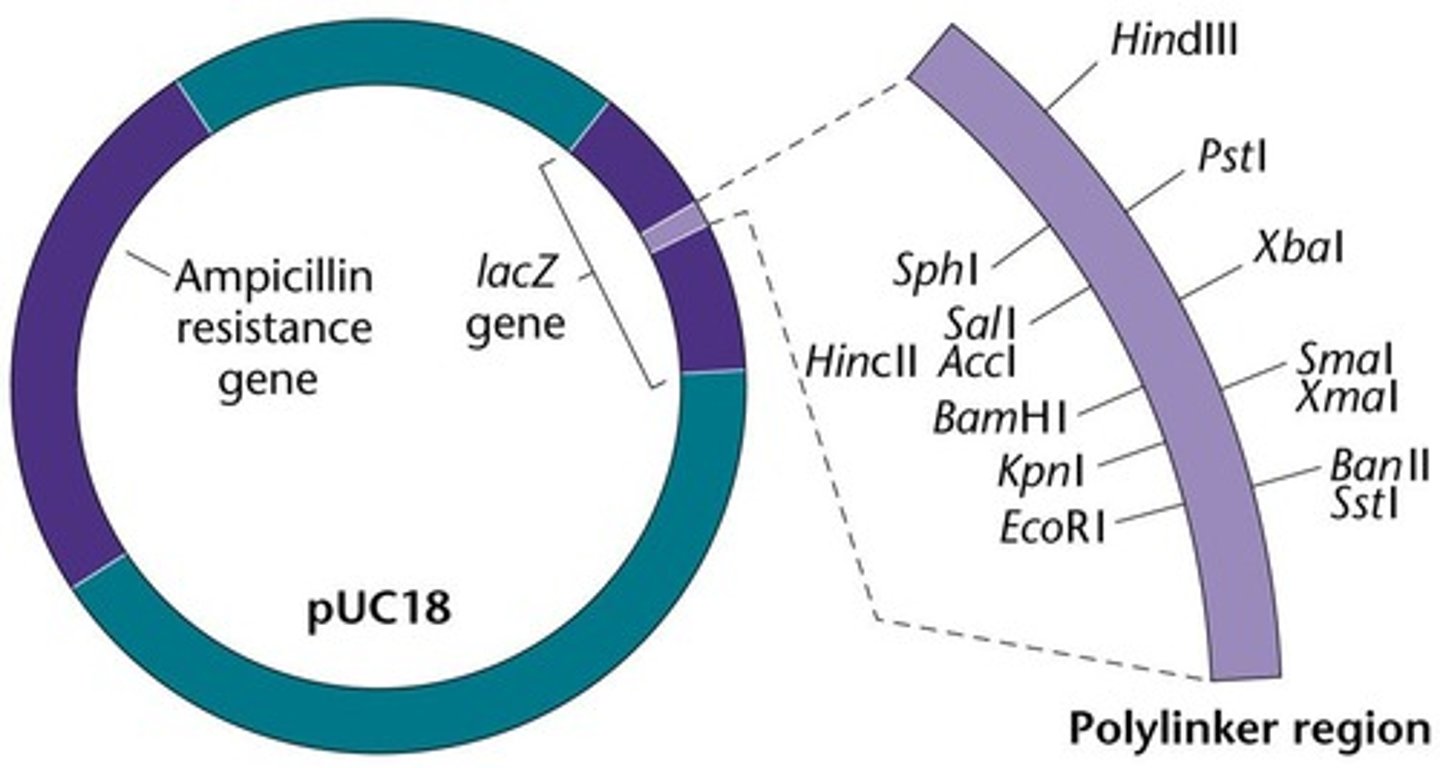
What happens when a foreign fragment of DNA is inserted into the polylinker region of pUC18?
Inserting a foreign fragment disrupts and disables the lacZ+ gene, making the plasmid lacZ-.
How is a recombinant plasmid created using a cloning vector like pUC18?
The plasmid is cut with a restriction enzyme (e.g., EcoR1), and a foreign DNA fragment is added, resulting in a recombinant plasmid.
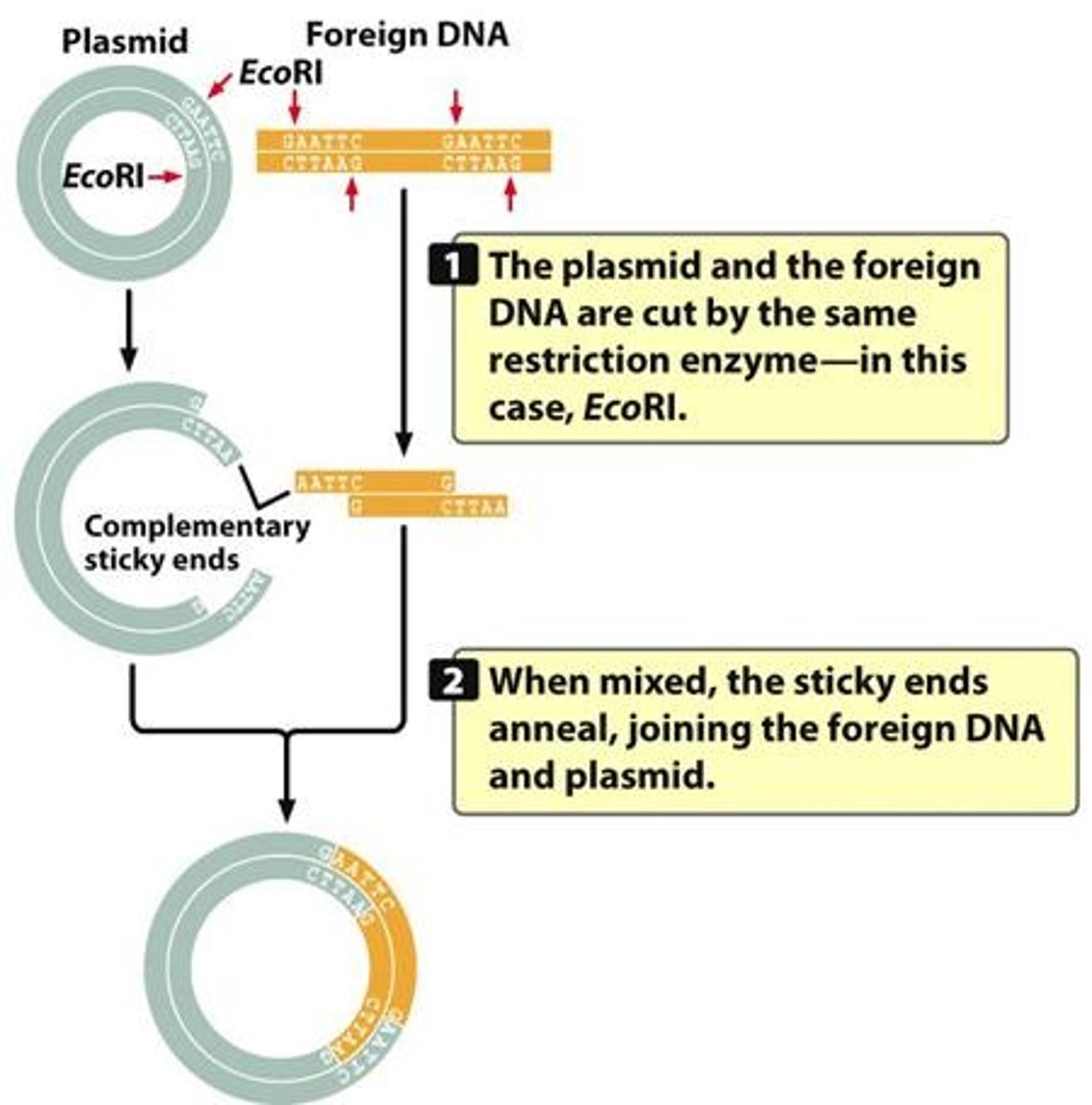
What is the process of transfection in recombinant DNA technology?
Transfection is the introduction of nucleic acids into cells by nonviral methods, allowing bacteria to multiply the recombinant plasmid.
What is the purpose of the antibiotic selection in cloning?
Antibiotic selection ensures that only bacteria carrying the correct antibiotic resistance gene (e.g., ampR) survive in the growth medium.
What role does the X-gal assay play in identifying E. coli colonies?
The X-gal assay identifies colonies with cloned DNA fragments by detecting b-galactosidase activity, which produces a blue dye.
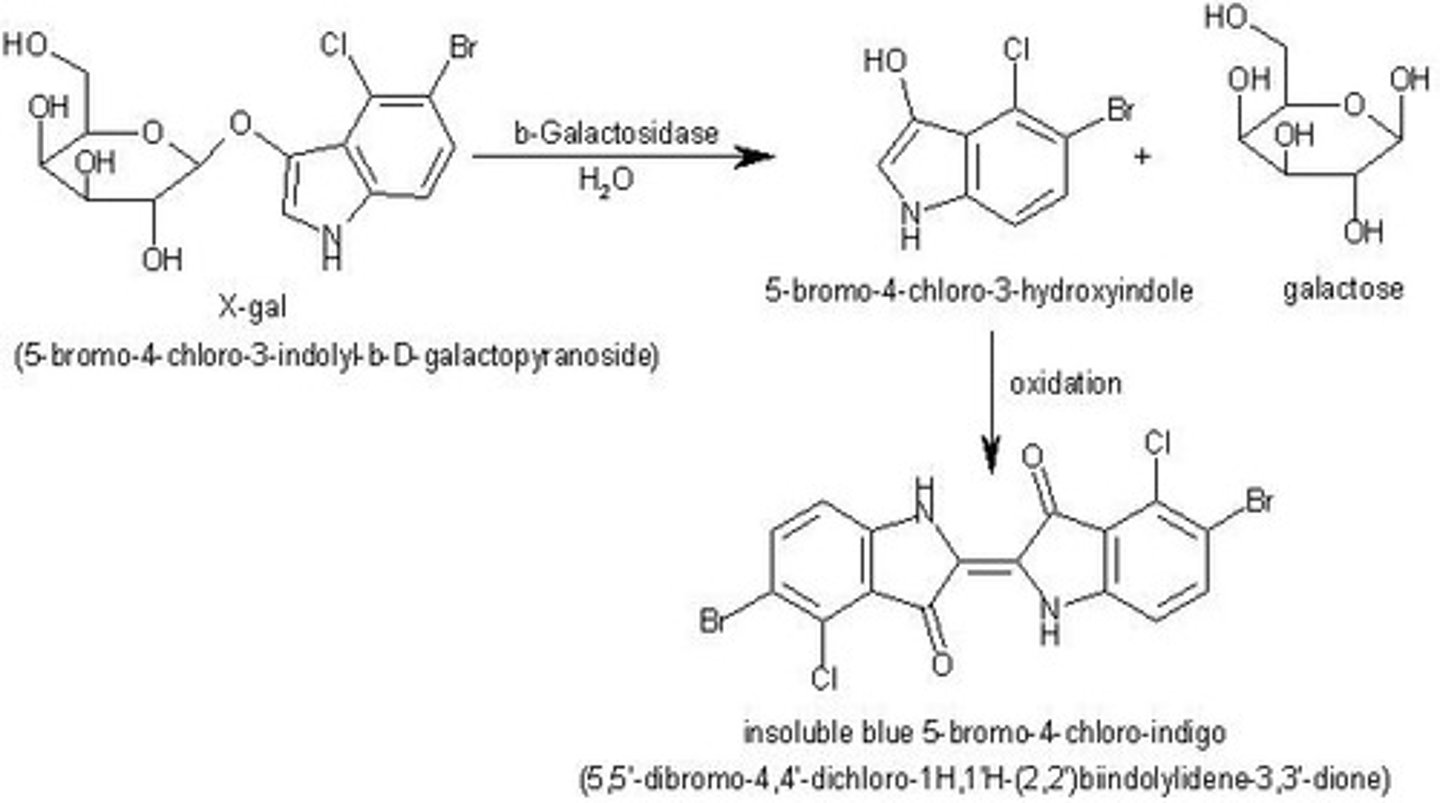
What is the significance of using a lacZ- strain of E. coli in cloning experiments?
A lacZ- strain cannot produce b-galactosidase unless it acquires an intact lacZ+ gene from a plasmid, allowing for blue-white selection.
What indicates that a plasmid has successfully incorporated foreign DNA during cloning?
If the lacZ+ gene is disrupted by the foreign DNA, the cells will not turn blue in an X-gal selection assay.
What is the function of b-galactosidase in the context of the X-gal assay?
b-galactosidase cleaves X-gal into galactose and an intermediate that oxidizes to form an insoluble blue dye.
What is the outcome when a plasmid remains lacZ+ after cloning?
The plasmid has no foreign DNA inserted and the E. coli colonies will turn blue in the X-gal selection assay.
What are RFLP and STR loci used for in forensic DNA profiling?
RFLP (Restriction Fragment Length Polymorphism) and STR (Short Tandem Repeat) loci are used to create DNA fingerprints for identification.
What is mitochondrial DNA used for in forensic analysis?
Mitochondrial DNA is utilized in forensics for profiling, especially in cases where nuclear DNA is not available.
What is the purpose of the double-selection assay in recombinant DNA technology?
The double-selection assay helps identify bacteria that have successfully taken up the recombinant plasmid by using both antibiotic resistance and color change.
What happens to E. coli colonies that do not take up the pUC18 plasmid?
E. coli colonies that do not take up the plasmid will not survive in the presence of ampicillin.
How does the disruption of the lacZ+ gene affect the color of E. coli colonies in the X-gal assay?
If the lacZ+ gene is disrupted, the colonies will remain white instead of turning blue, indicating the presence of foreign DNA.
What is the significance of the polylinker region in cloning vectors?
The polylinker region contains multiple restriction sites that allow for the insertion of foreign DNA fragments.
What is the role of EcoR1 in the creation of recombinant DNA?
EcoR1 is a restriction enzyme used to cut the plasmid and the foreign DNA, creating compatible sticky ends for ligation.
What is the final step after creating a recombinant plasmid?
The stable recombinant plasmid is introduced into bacteria, which then multiply and clone the plasmid.
What are the applications of recombinant DNA technology?
Applications include forensic DNA profiling, gene cloning, and the production of genetically modified organisms.
What happens to cells that pick up a recombinant plasmid in antibiotic selection?
Cells that picked up a recombinant plasmid (lacZ-) do not turn blue in the X-gal blue-white selection.
What do blue colonies indicate in the X-gal blue-white selection?
Blue colonies (X-gal positive) are cells that carry plasmids without an inserted foreign DNA.
What do white colonies indicate in the X-gal blue-white selection?
White colonies (X-gal negative) are cells that carry recombinant plasmids with an inserted foreign DNA.
What is the role of the Agrobacterium Ti plasmid in genetic engineering?
The Agrobacterium Ti plasmid can be used to transfer foreign genes into plants.
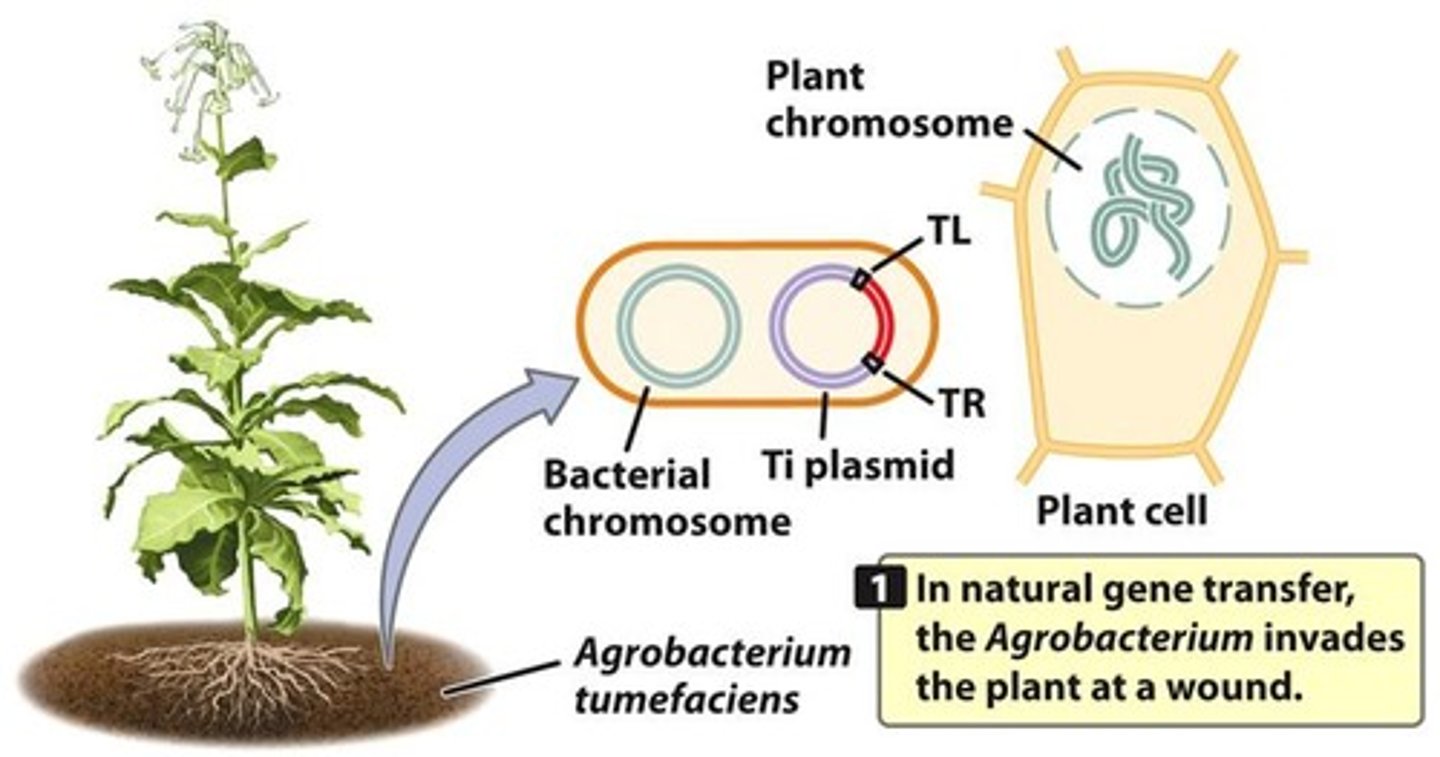
What are TL and TR in the context of the Agrobacterium Ti plasmid?
TL and TR are DNA sequences required for the transfer of segments of DNA from bacteria to plant cells.
How is glyphosate resistance achieved in transgenic crops?
Transgenic crops carry the EPSP gene under the control of a viral promoter, allowing them to express EPSP synthase at higher levels.
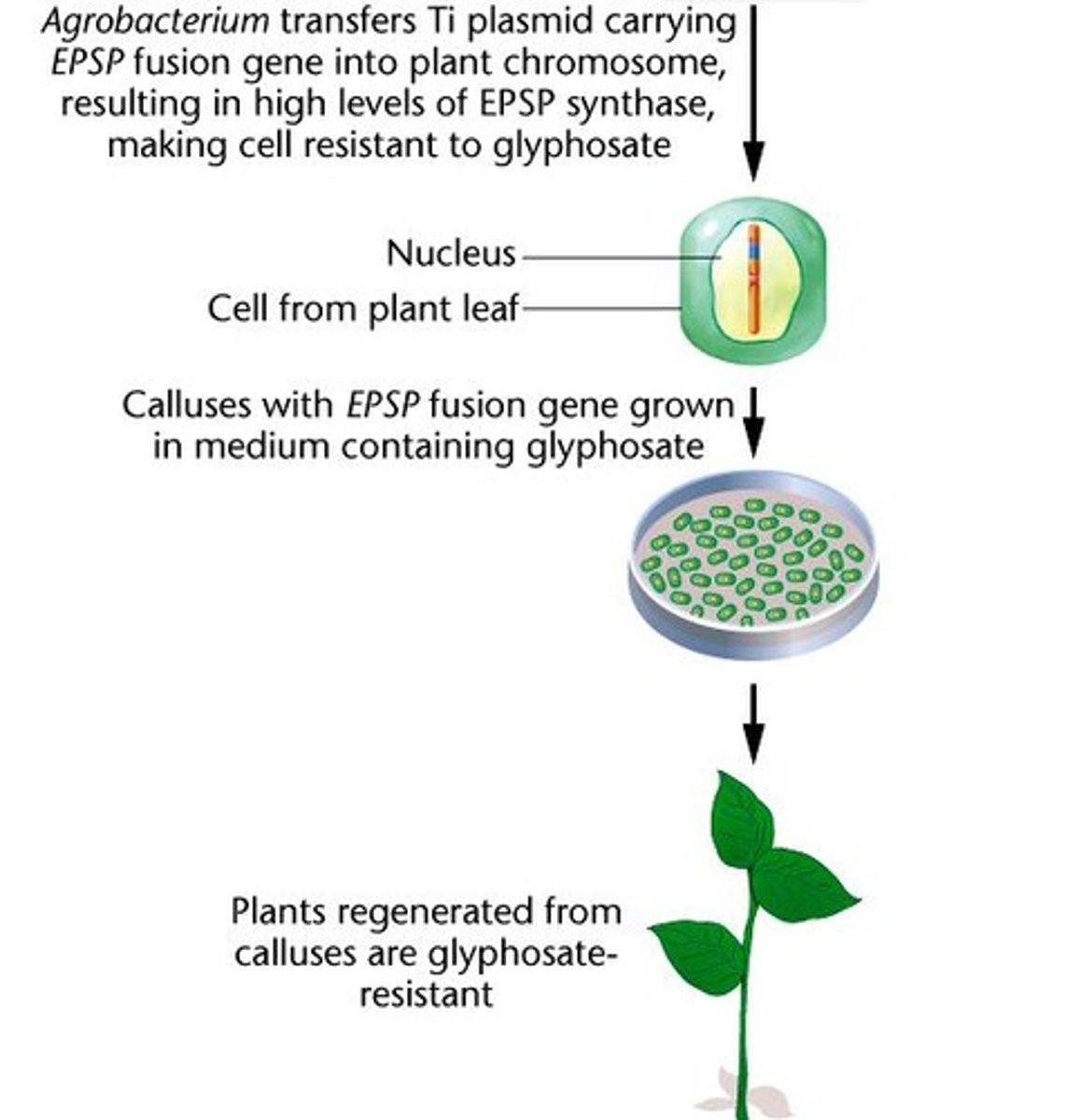
What is EPSP synthase and its significance in plants?
EPSP synthase is a chloroplast enzyme essential for amino acid biosynthesis, which is inhibited by glyphosate.
What is a callus in plant tissue culture?
A callus is a cluster of undifferentiated cells that results from the proliferation of a Ti-transformed cell in culture.
What is the purpose of generating knockout mice?
Knockout mice are created to study the effects of mutant genes in vivo.
What is homologous recombination in the context of gene targeting in mouse ES cells?
Homologous recombination involves the replacement of a normal cellular target gene with a disrupted version from a plasmid.
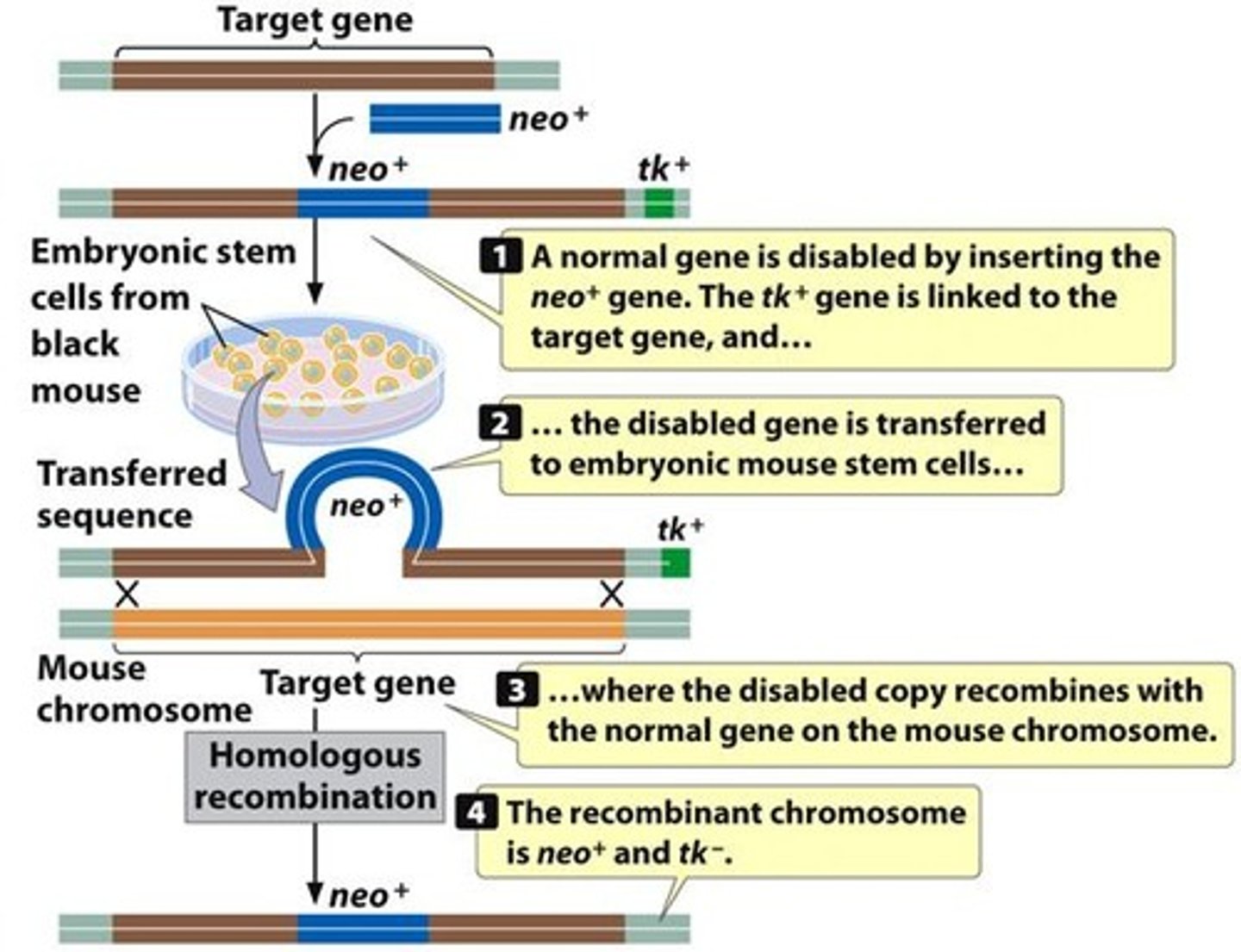
What is the role of the neomycin resistance gene (neo+) in generating knockout ES cells?
The neomycin resistance gene disrupts the target gene, making it a null mutant allele.

What is the function of the thymidine kinase (tk+) gene in the plasmid vector?
The tk+ gene can phosphorylate gancyclovir, turning it into a toxic inhibitor of DNA replication.
What are the two possible outcomes when introducing a plasmid into mouse ES cells?
1. A knockout occurs through homologous recombination. 2. Random integration of the entire plasmid vector occurs.
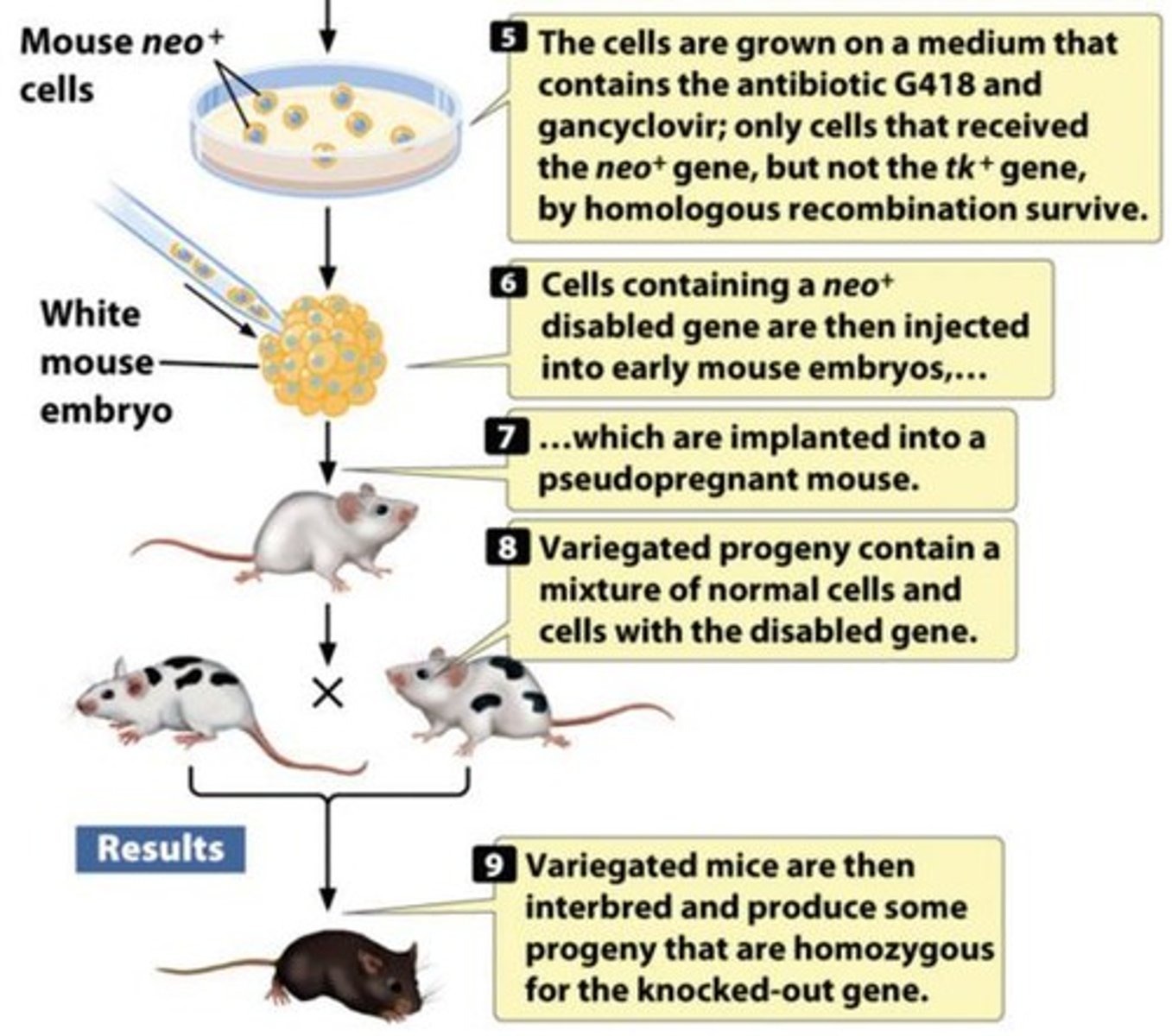
What characterizes cells that undergo a knockout in mouse ES cells?
They can grow in both neomycin and gancyclovir because the tk+ gene is not integrated into their genomes.
What happens to cells that randomly integrate the plasmid vector?
These cells cannot grow in medium containing gancyclovir because the tk+ gene is integrated and expressed, resulting in toxicity.
What is the significance of using a viral promoter in transgenic plants?
Viral promoters are very strong and can promote high levels of transcription of any genes placed in front of them.
What is the EPSP fusion gene in the context of transgenic crops?
The EPSP fusion gene has EPSP under the control of a viral promoter, allowing for increased expression.
What is the outcome of the integration of the Ti plasmid segment into plant DNA?
The segment flanked by TL and TR is transferred to a plant cell and integrated into its DNA.
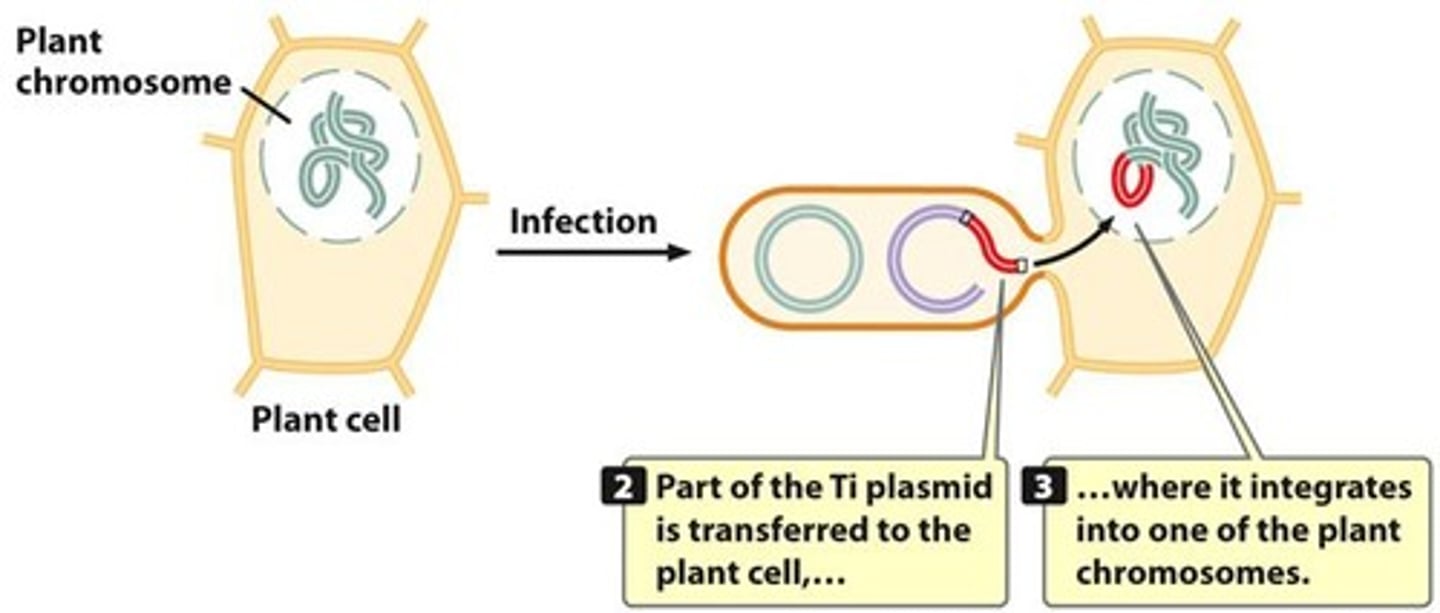
What is the role of the EPSP gene in glyphosate-resistant plants?
It allows plants to survive concentrations of glyphosate that would kill normal plants.
What is the significance of callus formation in plant biotechnology?
A callus can regenerate a complete transgenic plant.
What is the function of the neomycin resistance gene in the context of knockout mice?
It allows for the selection of cells that have undergone homologous recombination.
What is a transgenic organism?
A transgenic organism is one that has been genetically altered to carry genes from another species.
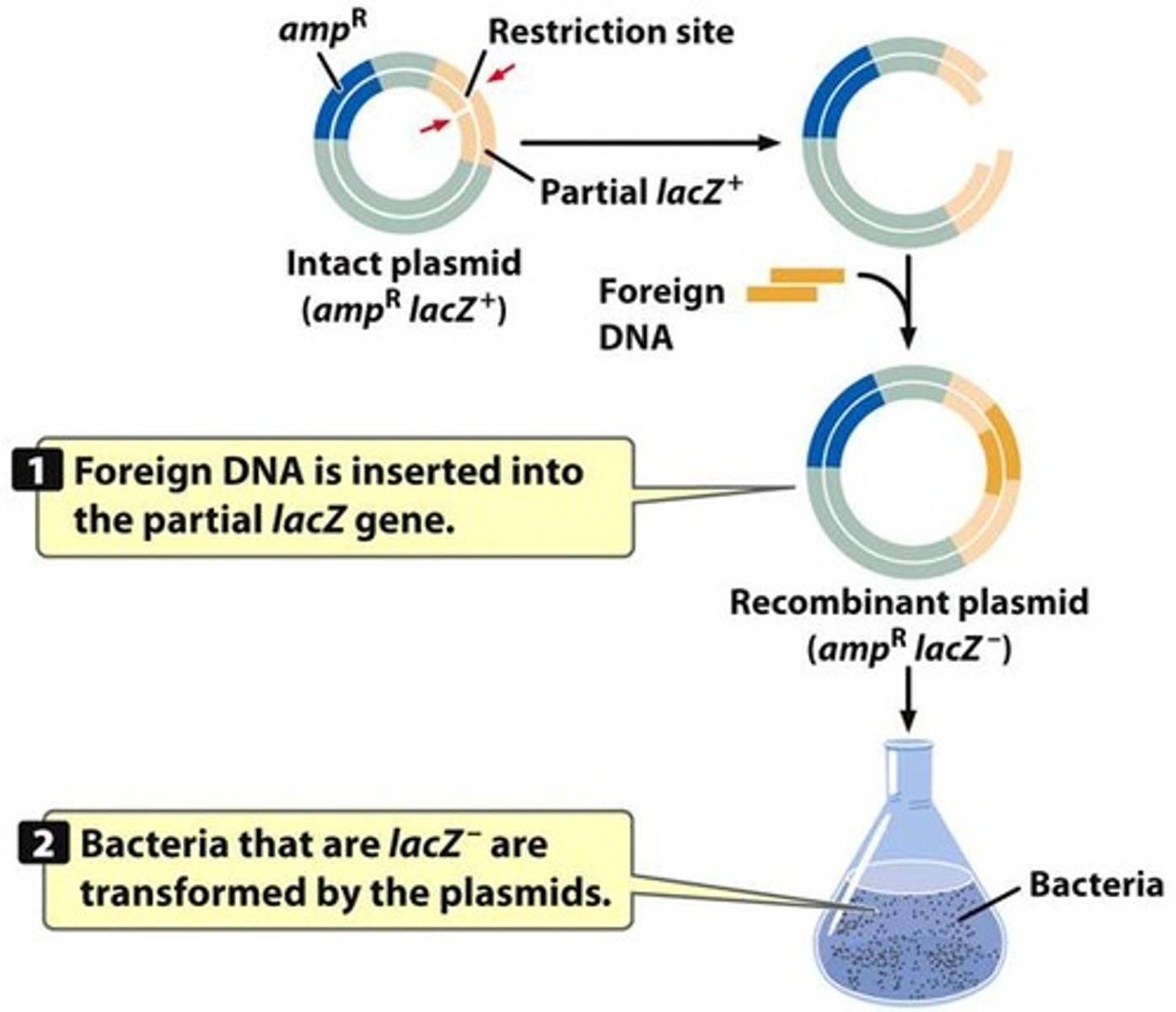
What is the purpose of creating knockout mice?
To disable a target gene for research purposes.
What technique is used to disrupt a gene in knockout mice?
Double crossing over of homologous sequences in a plasmid.
What happens during random integration of a plasmid into a host cell chromosome?
If a single crossing over occurs, the entire plasmid becomes integrated into the chromosome.
How are knockout ES cells used to create knockout mice?
Knockout ES cells from a black mouse are injected into the early embryo of a white mouse, resulting in a chimeric mouse.
What is a chimeric mouse?
A mouse that develops from a hybrid embryo containing cells from two different mice.
What is forensic DNA profiling?
The use of genetic markers to distinguish individuals and answer legal questions.
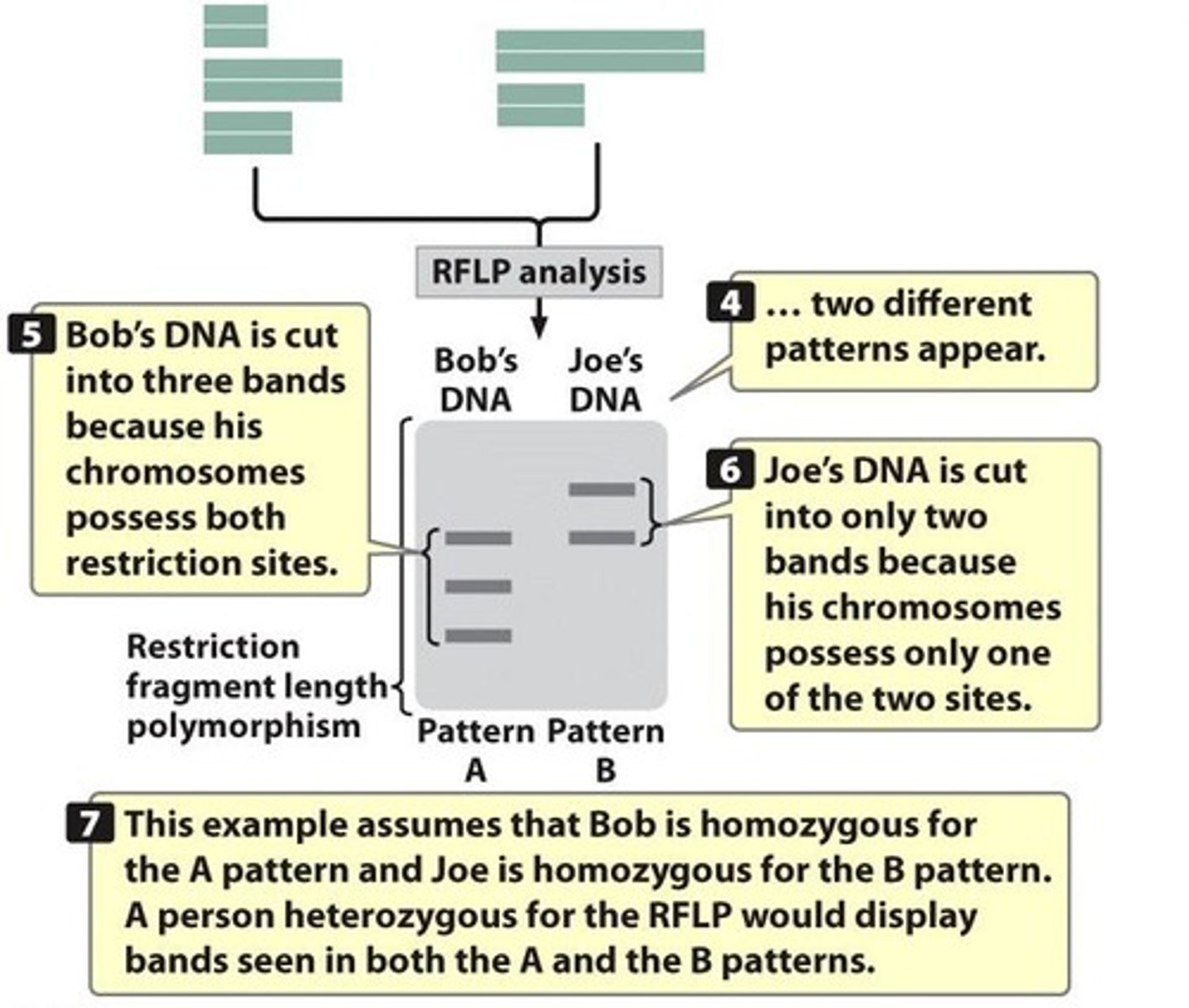
What are RFLPs?
Restriction fragment length polymorphisms, which are loci that vary in the number and position of restriction sites.
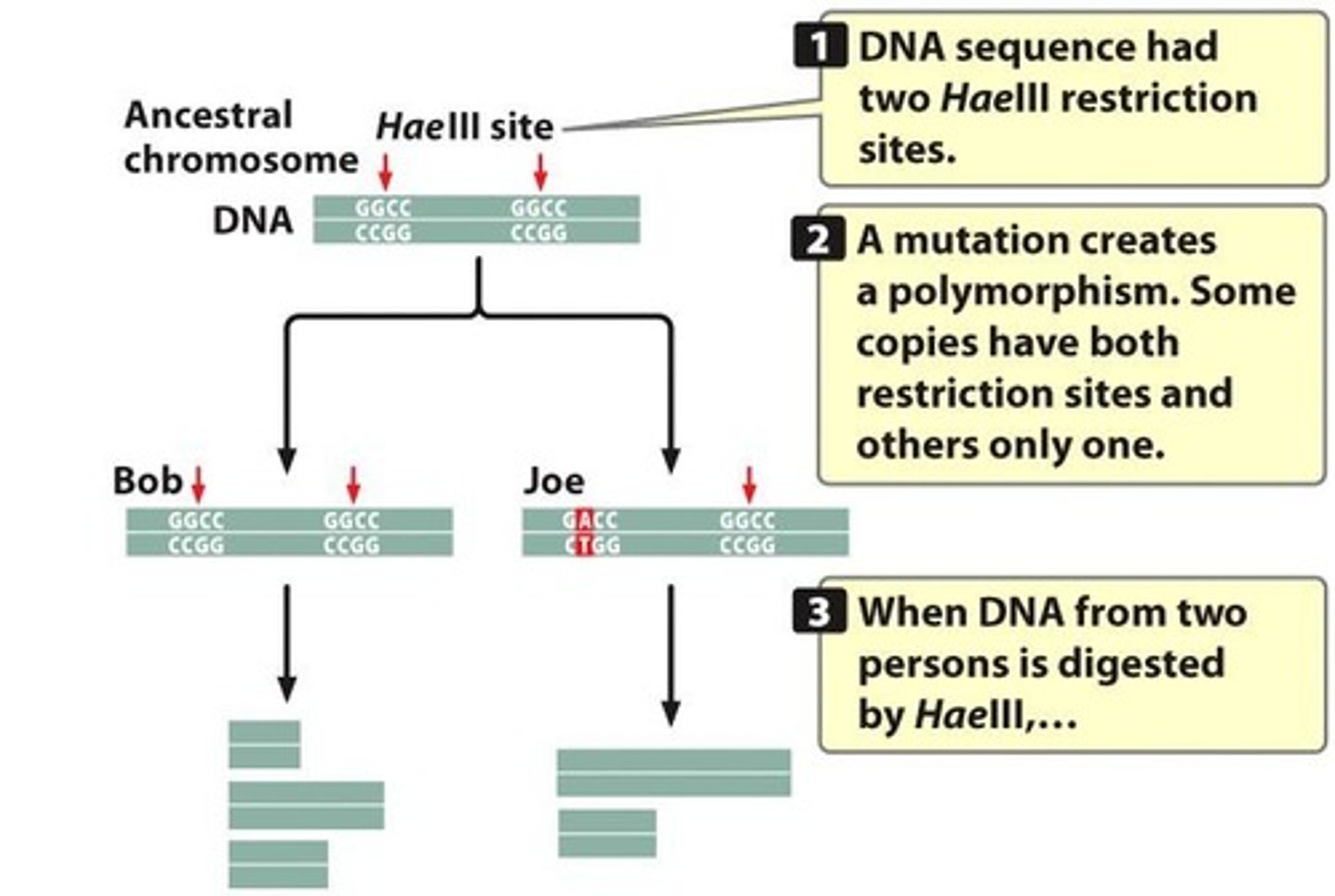
What are STR loci?
Short tandem repeats, which are loci containing variable numbers of repeats of short sequences (microsatellites).
What is the significance of the D7S820 PCR locus?
It is one of the 13 STR markers used by the FBI, located on human chromosome 7, with variable GATA repeat numbers.
What are microsatellites?
Clusters of tandem repeats of 2 to 5 nucleotide sequences found in STR loci.
How does STR analysis benefit from PCR?
PCR allows for rapid analysis with very little tissue sample required.
What is the expected result of PCR in a homozygous individual?
A single band corresponding to a single PCR product.
What would be the result of PCR in a heterozygous individual?
Both bands of PCR products would show, indicating different alleles.
What is the role of primers in PCR for STR analysis?
Primers anneal just outside the region of the locus containing microsatellite repeats, determining the length of PCR products.
What results from using multiple pairs of primers in a PCR reaction?
A unique DNA fingerprint pattern of bands corresponding to several PCR loci.
What are non-coding polymorphic loci?
Genetic markers used in forensic DNA profiling that do not code for proteins.
What is the main limitation of RFLP analysis?
It is now considered an outdated method for DNA profiling.
What is the relationship between the number of repeats in STR loci and individual variation?
The number of repeats varies among individuals, contributing to unique DNA fingerprints.
What does the term 'homozygous' refer to in genetics?
An individual with two identical alleles for a specific gene.
What does the term 'heterozygous' refer to in genetics?
An individual with two different alleles for a specific gene.
How does the integration of knockout ES cells into mouse embryos contribute to genetic research?
It allows for the study of gene function and the effects of gene knockout in living organisms.
What is the significance of genetic markers in the legal system?
They provide a means to identify individuals and establish biological relationships.
What is the outcome when chimera mice are mated?
Some progeny may be homozygous knockout mice.

What is CODIS?
CODIS (Combined DNA Index System) is the national DNA database established by the FBI to enable forensic laboratories to create searchable DNA profiles.
What are the FBI's 13 core STR loci used for?
They are used in DNA fingerprinting to identify individuals based on their unique DNA profiles.
What does it mean if an individual is homozygous for a DNA locus?
It means that the individual has two identical alleles for that locus.
What does it mean if an individual is heterozygous for a DNA locus?
It means that the individual has two different alleles for that locus.
How can PCR products be detected during DNA fingerprinting?
PCR products can be tagged with fluorescent labels and detected with a laser beam as they migrate during electrophoresis.
What is the purpose of the amelogenin test in DNA analysis?
The amelogenin test is used for sex determination of human DNA samples.
What are the PCR product sizes for AMEL-X and AMEL-Y?
PCR of AMEL-X gives a 106 bp product, while PCR of AMEL-Y gives a 112 bp product.
What was the method of choice for DNA analysis in the identification of September 11 victims?
The method of choice was PCR (Polymerase Chain Reaction).
What challenges were faced in identifying victims of the September 11 attacks?
Only 293 whole bodies were recovered from 2603 victims, with many pieces of bone and tissue found among the debris.
What DNA evidence linked O. J. Simpson to the murder of Nicole Brown?
O. J. Simpson's blood was found at the crime scene, leading to a DNA profile match.
What was significant about the DNA evidence in the O. J. Simpson trial?
DNA profiles from both Nicole Brown and Ronald Goldman were also found at the crime scene, linking them to Simpson.
What historical event led to the murder of Tsar Nicholas II and his family?
The Russian Revolution of 1917 resulted in the end of the Russian Empire.
What was the identity claim of Anna Anderson?
Anna Anderson claimed to be Anastasia Romanov, the youngest daughter of Tsar Nicholas II.
What did DNA tests reveal about Anna Anderson's identity?
Her mitochondrial DNA did not match that of Prince Philip, a relative of Anastasia, but matched that of Carl Maucher, a relative of Franziska Schanzkowska.
What is mitochondrial DNA (mtDNA) used for in forensic identification?
mtDNA is used to trace maternal lineage and establish identities based on maternal relatives.
What was the outcome of the investigation into Anna Anderson's identity?
She was believed to be Franziska Schanzkowska, a Polish factory worker.
What is the significance of the 1991 exhumation of the Romanov family?
It allowed for DNA testing to confirm the identities of the murdered family members.
What role did PCR play in the forensic analysis of the Romanov family?
PCR was used to analyze mitochondrial DNA markers to establish identities.
What were some personal items collected from victims' homes after the September 11 attacks?
Items included razor blades, combs, toothbrushes, and other personal belongings.
What is the importance of polymorphic sites in mitochondrial DNA analysis?
Polymorphic sites are single-nucleotide positions that can vary among individuals, aiding in identification.
How many pieces of bone and tissue were found among the debris of the World Trade Center?
Approximately 20,000 pieces of bone and tissue were recovered.
What was the primary focus of the forensic investigation in the O. J. Simpson case?
The focus was on matching DNA profiles from blood samples found at the crime scene.
What is the relevance of the year 1984 in relation to Anna Anderson?
Anna Anderson died on February 12, 1984, and was known for claiming to be Anastasia Romanov.